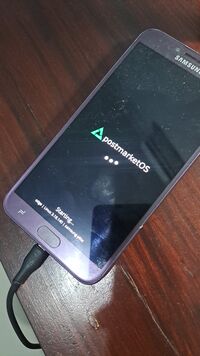Samsung Galaxy J4 (samsung-j4lte)
| This device runs a Downstream kernel. Some UIs will not work, and most features (3D acceleration, audio, etc.) may be broken. |
 Samsung Galaxy J4, on postmarketOS boot splash screen | |
| Manufacturer | Samsung |
|---|---|
| Name | Galaxy J4 |
| Codename | samsung-j4lte |
| Model | SM-J400 |
| Released | 2018 |
| Type | handset |
| Hardware | |
| Chipset | Samsung Exynos 7570 Quad |
| CPU | 4x 1.4 GHz ARM Cortex A53 |
| GPU | Mali T720 |
| Display | 720x1280 IPS |
| Storage | 32 GB |
| Memory | 2 GB |
| Architecture | aarch64 |
| Software | |
Original software The software and version the device was shipped with. |
Android 10 |
Extended version The most recent supported version from the manufacturer. |
Android |
| postmarketOS | |
| Category | downstream |
Mainline Instead of a Linux kernel fork, it is possible to run (Close to) Mainline. |
no |
pmOS kernel The kernel version that runs on the device's port. |
3.18.140 |
Unixbench score Unixbench Whetstone/Dhrystone score. See Unixbench. |
1492.7 |
| Device package |
|
| Kernel package |
|
Flashing Whether it is possible to flash the device with pmbootstrap flasher. |
Partial
|
|---|---|
USB Networking After connecting the device with USB to your PC, you can connect to it via telnet (initramfs) or SSH (booted system). |
Works
|
Internal storage eMMC, SD cards, UFS... |
Works
|
SD card Also includes other external storage cards. |
Untested
|
Battery Whether charging and battery level reporting work. |
Works
|
Screen Whether the display works; ideally with sleep mode and brightness control. |
Works
|
Touchscreen |
Works
|
| Multimedia | |
3D Acceleration |
Untested
|
Audio Audio playback, microphone, headset and buttons. |
Broken
|
Camera |
Broken
|
Camera Flash |
Untested
|
| Connectivity | |
WiFi |
Works
|
Bluetooth |
Untested
|
Ethernet |
Untested
|
GPS |
Untested
|
| Modem | |
Calls |
Untested
|
SMS |
Untested
|
Mobile data |
Untested
|
| Miscellaneous | |
FDE Full disk encryption and unlocking with unl0kr. |
Untested
|
USB OTG USB On-The-Go or USB-C Role switching. |
Untested
|
| Sensors | |
Accelerometer Handles automatic screen rotation in many interfaces. |
Untested
|
Magnetometer Sensor to measure the Earth's magnetism |
Untested
|
Proximity |
Untested
|
Hall Effect Measures magnetic fields; usually used as a flip cover sensor |
Untested
|
Haptics |
Untested
|
Barometer Sensor to measure air pressure |
Untested
|
Power Sensor Sensor to monitor current, voltage and power. Not fuel gauge! |
Untested
|
Contributors
- manoedinata
Users owning this device
- IOrbitSaturn (Notes: J400M, broken screen, will install postmarketOS for testing later :D)
- Manoedinata (Notes: Normal condition. Used as small home server)
- Predefine (Notes: Use as server for small stuff)
How to enter flash mode
+ +
In some cases, using power button to boot into Download Mode doesn't work. Instead, while pressing + , connect the device to PC via USB. Don't release the buttons until you're in the Download Mode.
Installation
Use pmbootstrap to build your own installation image. The device configuration will also build firmware package, which contains required proprietary blobs for Wi-Fi.
Heimdall installation doesn't work. Use Installation_from_recovery_mode instead.
Known Working
- Touchscreen
- Screen & display
- Framebuffer (additionally with
msm-fb-refresherto refresh the screen) - Charging & battery status
- Wi-Fi (partially, with firmware package)
Notes
Wi-Fi
To enable Wi-Fi, these proprietary blobs are required to be loaded:
vendor/etc/wifi/mx vendor/etc/wifi/mx140.bin vendor/etc/wifi/mx140_wlan.hcf
These files are pulled and packaged already in firmware-samsung-j4lte pmaports package.
Framebuffer
Some patches are required for framebuffer to fix some issues, e.g. swapped color.
The kernel panics with null pointer dereference if running framebuffer-based or text interfaces with CONFIG_FRAMEBUFFER_CONSOLE, or if you want to display kernel console to the screen. So, none or console environment doesn't show anything.
Newer DECON drivers as seen in newer devices e.g. Samsung Galaxy A51 (samsung-a51) also have similar issue, and can be fixed by keeping fb0 enabled. Could it be the same reason for our device? |
See also
- pmaports!5936 Initial merge request